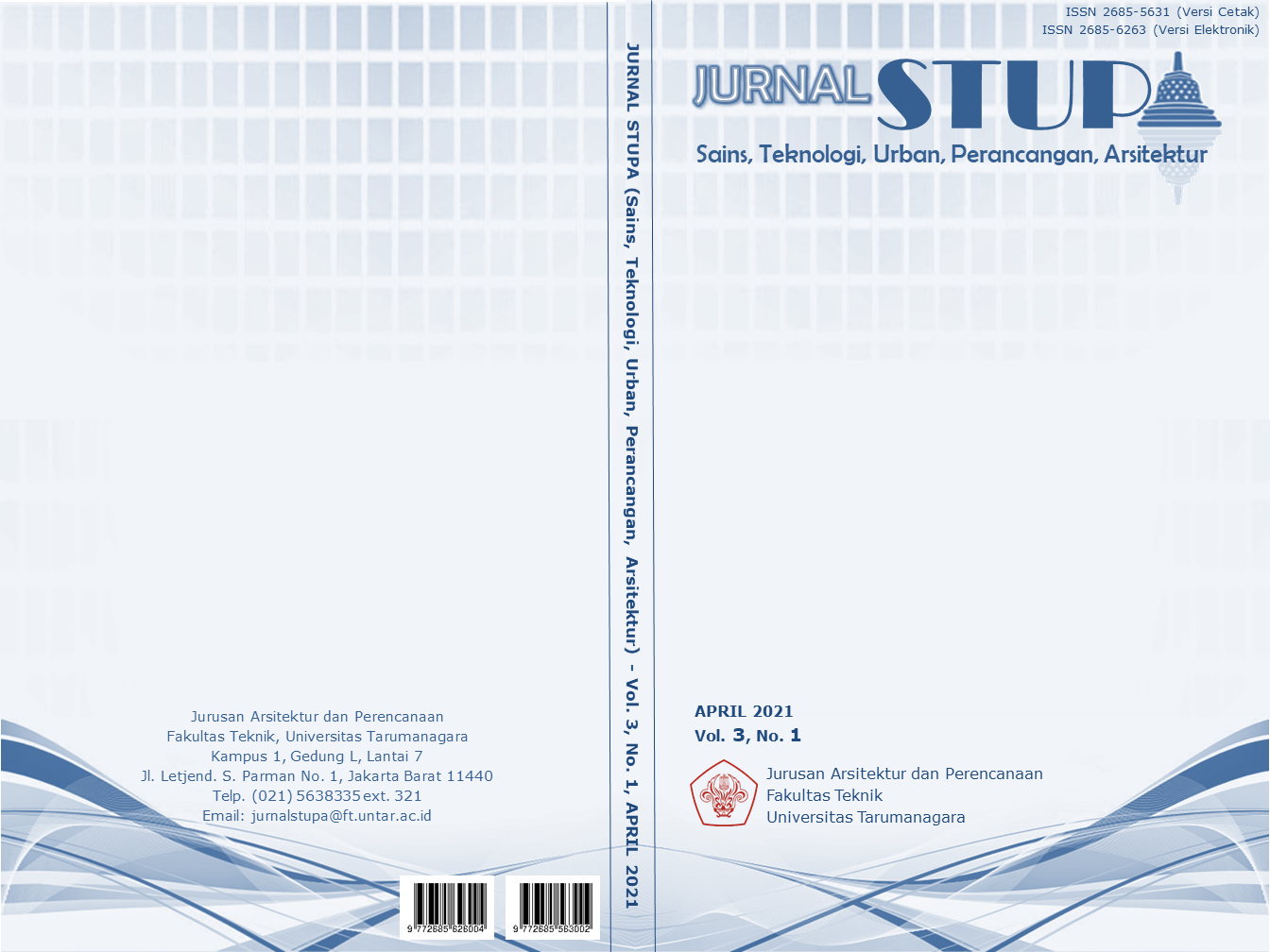PENERAPAN ARSITEKTUR LINGKUNGAN BELAJAR YANG IDEAL PADA TEMPAT BELAJAR BIO-TEK KEBON JERUK
Main Article Content
Abstract
The world is currently faced with an era of technological disruption in the 4.0 industrial revolution which is marked by the emergence of Big Data, Artificial Intelligence, industrial autonomization, IoT, and others. Those things bring benefits and problems that must be overcome. The impact of this innovation can be felt by all groups, not only adults, rich people, entrepreneurs, people expert in technology, teenagers, and even children today. Humans need to adapt and mitigate these changes in order to survive in this condition, one of which is through education. The world of education needs to shift the education system because currently the condition of education, especially schools, is still using learning methods like the 2.0 era so that is is not suitable in this 4.0 era. The education strategy to face the era of the industrial revolution 4.0 is to immediately increase the capabilities and skills of human resources, equipped with invisible abilities, such as personal skills, global thinking, digital literacy, critical thinking, problem solving, communication, collaboration and. Advancement of information technology-based education will answer the challenges of industry 4.0. Kebon Jeruk Bio-Tech Learning space is a place for learning that is more flexible and suitable for building student character and creativity. Room quality, configuration and facilities must be adapted to the us of technology that is currently increasing. There is also need of special guidance from the community in responding to the increasing popularity of technology in this era of disruption, increase the closeness between general citizens in anticipating the negative effects of technology.
Keywords: dwell; education ; industrial revolution 4.0 ; learning space
Abstrak
Dunia saat ini tengah dihadapkan dengane era disrupsi teknologi revolusi industri 4.0 yang ditandai dengan munculnya Big Data, Aritificial Intelligence, otonomisasi industri, IoT, dan lain-lain. Hal tersebut membawa segala kemajuan dan masalah yang harus dilalui. Dampak kecanggihan ini dapat dirasakan semua kalangan, bukan hanya orang dewasa, orang kaya, pengusaha, orang-orang ahli bidang teknologi, remaja bahkan anak-anak saat ini. Manusia perlu beradaptasi dan mitigasi di tengah perubahan ini agar tetap dapat dwell di kondisi ini, salah satunya melalui pendidikan. Dunia pendidikan perlu menggeser sistem pendidikannya karena saat ini kondisi pendidikan khususnya sekolah masih menggunakan metode belajar seperti era 2.0 sehingga dirasa kurang sesuai di era 4.0 ini. Strategi pendidikan menghadapi era revolusi industri 4.0 adalah segera meningkatkan kemampuan dan keterampilan sumber daya manusia yang dilengkapi dengan kemampuan tak kasat mata, seperti keterampilan interpersonal, berpikir global, literasi digital, berpikir kritis, pemecahan masalah, kemampuan berkomunikasi, kolaborasi dan kreativitas. Kemajuan pendidikan berbasis teknologi informasi akan menjawab tantangan industri 4.0. Kebon Jeruk Bio-Tech Learning space merupakan tempat belajar yang dirancang dengan metode linkungan belajar yang ideal, ruang sebagai guru ke-3, neuroarsitektur, dan biofilik desain dimana menghasilkan ruangan lebih fleksibel, kolaboratif dan sesuai untuk membangun karakter dan kreativitas para murid. Kualitas ruang, konfigurasi ruang, dan fasilitas juga disesuaikan dengan penggunaan teknologi yang akan semakin berkembang. Perlu juga adanya bimbingan khusus dari masyarakat dalam menyikapi semakin maraknya teknologi di era disrupsi ini, meningkatkan kedekatan antar warga umum dalam mengantisipasi dampak buruk teknologi.
Article Details
References
Badan Pusat Statistik. (2019). Kecamatan Kembangan Dalam Angka 2019. Jakarta: Badan Pusat Statistik Kota Administrasi Jakarta Barat
Browning, W. (2014). 14 Patterns of Biophilic Design Improving Health and Well-Being in the Built Environment. New York: Terrapin Bright Green
Ching, F. D.K. (1979). Architecture: Form, Space and Order dalam versi Bahasa Indonesia diterjemahkan oleh Ir. Paulus Hanoto A. Jakarta: PT. Erlangga. menggunakan ide/gagasan, data, atau metode yang didapat dari sumber-sumber tertentu pada saat melakukan penelitian. Diakses dari http://www.uq.edu.au/nextgenerationlearningspace/
Envision.com (2017, 21 Juli). 6 Keys elements of 21st Century Classroom Design. Diakses dari: https://www.envisionexperience.com/blog/6-key-elements-of-21st-century-classroom-design
Harari, Y. N. (2018). 21 Lessons for the 21st Century. Israel: Spiegel&Grau, Jonathan Cape
Heidegger, M. (1971). Dwelling Thinking Building, from Poetry, Language, Thought, translated by Albert Hofstadter. New York: Harper Colophon Books.
King, P. (2004). Private Dwelling Contemplating the Use of Housing. London: Routledge
Kompas.com (2020, 3 April). Hadapi Revolusi Industri 4.0 Dunia Pendidikan Harus Bagaimana? Diakses dari: https://www.kompas.com/edu/read/2020/04/03/162000071/hadapi-revolusi-industri-40-dunia-pendidikan-harus-bagaimana
Lange, A. (2018). The Design of Childhood: How the Material World Shapes Independent Kids. London: Bloomsbury publishing
Minero, E. (2018). The Architecture of Ideal Learning Environment. Diakses dari https://www.edutopia.org/article/architecture-ideal-learning-environments#:~:text=Key%20insights%20into%20five%20common,learning%E2%80%94surfaced%20during%20our%20conversations.
Radcliffe, D., et al. (2008). Designing Next Generation Place of Learning: Collaboration at the Pedagogy-Space-Technology Nexus. University of Queensland. Australia
Staehli, B. (2018). Montessori Architectural Patterns. Diakses dari https://www.researchgate.net/publication/327605241_Montessori_Architectural_Patterns
Thornton, L. (2015). Understanding the Reggio Approach Early Years Education in Practive. London: Taylor&Francis Group



